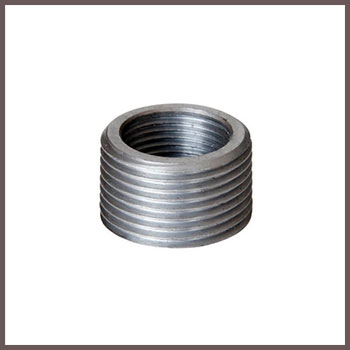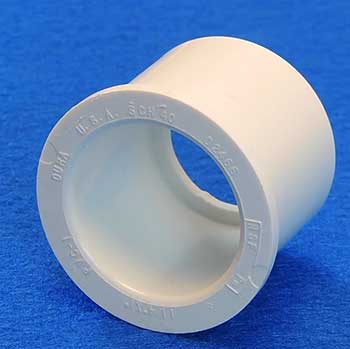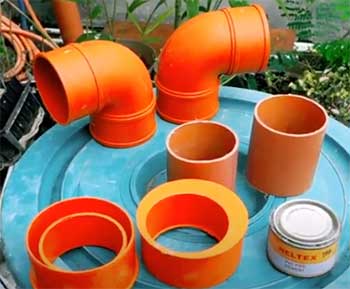The only difference between a flush bushing and a reducer is their construction, but they have the same purpose. Usually, a flush bushing accepts a pipe of a larger diameter and reduces its flow through the smaller diameter.
One can also find the flush bushing attaching the same pipes to increase their length.
However, the reducer is usually made in a shape that accepts a larger diameter pipe from one side and reduces the flow of water by connecting it with a smaller diameter pipe.
Besides, these have a lot of similarities in pricing, durability, and other considerable factors.
A Quick Comparison Table
| Specific Comparison Factors | Flush Bushing | Reducer/expander |
| Purpose | To decrease or reduce the flow of water or liquid from a larger pipe to a smaller one and vice versa | To decrease or reduce the flow of water from a larger pipe to a smaller pipe and vice versa |
| Construction | Usually, these have extra sections added to reduce or increase the diameter of the pipes | These reducers or expanders are made in shape as one accepting the larger or smaller pipe |
| Available in | Stainless Steel Heavy Duty plastic | Stainless Steel Heavy Duty Plastic |
| Made For | Various types of pipes with various cone sizes | A wide variety of pipes with multiple cone sizes |
| Usage | In a lot of plumbing applications or where applicable and usually fit able at compact places | In a lot of plumbing applications or where applicable and usually fit able at vast places |
| Pricing | From $5 to $10 for both plastic and stainless-steel fittings | From $5 to $15 for both plastic and stainless-steel fittings |
| Available at | Multiple websites, stores, and brands | Multiple websites, stores, and brands |
Flush Bushing Overview
A flush bushing, also known as a reducing bushing, is a simple cylindrical fitting with male or female threads of different sizes on each end. This allows it to join two pipes or openings of different diameters.
For example, a bushing may have a 1/2″ female thread on one end and 3/4″ male thread on the other end. This could connect a 1/2″ pipe to a 3/4″ opening. The bushing fills the gap between the two sizes for a secure fit.
Advantages:

- Inexpensive and widely available
- Simple design easy to install
- Can be used for low pressure non-critical applications
- Flows in either direction
Disadvantages:
- Causes turbulent, disruption in flow
- Higher pressure drop across fitting
- Not recommended for steam, HVAC, water lines
Flush bushings are useful for electrical conduits, low pressure plumbed drains, venting applications and short stub outs where smooth flow is less critical.
Reducer Overview
A reducer fitting has ends of two different sizes like a bushing, but with a tapered conical section in the middle to transition between the two. This gradual taper allows for smoother flow compared to an abrupt step down in a bushing.
Reducers are made of cast iron, steel or plastic materials. They may have threaded, plain or belled ends depending on the installation needs.
Advantages:
- Gradual taper minimizes turbulence
- Lower pressure drop
- Preferred for water, steam, gas, HVAC lines
- Some types can reduce in size by more than one pipe size
Disadvantages:
- More expensive than bushings
- Directional flow per taper
- Harder to install in tight spaces
Reducers are ideal for situations requiring less disrupted laminar flow. The tapered section maintains smoother transitions in these critical systems.
Key Differences Between Flush Bushing And Reducer
- Purpose

We can say that the flush bushing and a reducer are designed for the same purpose, to reduce or increase the flow of something.
Besides, these tools can also be used to divert flow direction from one angle to another.
On the contrary, you will always find the flush bushing coming in a shape that connects a pipe of a larger diameter with a smaller diameter.
In this way, you decrease the flow of water. A flush bushing may not help you in increasing the flow of water.
But it can help attach two pipes if you need to increase the length of a complete connection.
However, the reducer only attaches a male pipe to the female pipe.
It is designed to accept a larger opening pipe and connect it with the smaller one.
The alternative to a reducer is an expander which can be used to connect a smaller diameter pipe with a larger diameter to increase the flow.
Also, these are used to divert the direction of flow in plumbing, gas, electricity, and other applications.
- Construction
In order to judge which one is a reducer and which is a flush bushing, you must look at their construction.
We usually find an extra layer of plastic or blockage in a flush bushing that helps complete the connection and achieve the purposed flow.
Moreover, these bushings are also available in the same shape to connect similar-diameter pipes.
Compared to that, you will find the reducer made in a shape that will be small from one side and larger from the other.
The larger accepts a broader diameter pipe, whereas the smaller accepts the smaller diameter pipe.
Only the design helps you identify the most significant difference between these two.
- Available In
The best similarity between these two joints is they are both made with heavy-duty plastic.
Or one can find them stainless steel made. Therefore, you can choose any depending on your best requirements.
- Made For
We can always find the flush bushings and the reducers or expanders accepting various pipe sizes.
You can believe that the sizes of these joints will match the sizes of all types of pipes available in the market.
- Usage

As mentioned earlier, the flush bushes will be best to use at most compact places.
Because these plumbing tools do not cover much area.
On the other hand, you can use the Reducers or Expanders at plumbing places with more space.
Plus, you can fix them quickly, depending on the space requirement.
- Pricing
Both tools do not have any significant differences in their prices. However, the reducers might cost you a few bucks more than flush bushings.
Because more material is used in the construction of reducers than bushings.
- Available At
Nothing is concerned regarding the durability or quality of these jointers. You can find them at multiple online or physical stores.
Besides, they are also being sold by multiple brands in the market.
Which Is Better To Use?
In my case, I would always recommend using Bushings over reducers. Because these tools cover less space and are still applicable for the same tasks.
On the other hand, if you are easy to go with the reducers or expanders, there will not be any problems. So, It depends on you which suits best to your plumbing needs.
Frequently Asked Questions (FAQ)
The only difference you will find between these two is in their design and way of construction. For usage purposes, they are similar.
A Flush bushing is used to connect a larger diameter pipe with a smaller diameter and vice versa to reduce or increase the flow of water.
Yes, it is similar because it comes with a minor female thread on the internal side and a male thread on the outer side. It is also used to reduce the diameter of pipes.
A reducer usually accepts pipe on either end to increase or decrease the water flow. A coupling could be a reducer and a tool designed to attach two pipes.
Bell reducers provide a gradual taper which minimizes disruption to flow. This results in lower pressure drop compared to the abrupt step down of a bushing. Bell reducers are preferred for HVAC, steam, water lines.
A reducing bushing allows the connection of pipes or openings of different sizes. It has male or female threading of distinct diameters on each end to fill the size discrepancy. It offers a basic, low-cost transition fitting.
Final Wording
If you have come this far, you probably know the fundamental differences between the flush bushing and the reducer. To name a few, they are the same things to use in plumbing.
The differences come in the sizes, design, and thread sizes on the internal and external sides of a bushing.
But one can use either a reducer or a flush bushing to achieve that plumbing task. You will not find yourself in hassles while using any of these tools.

